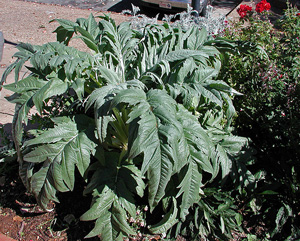Resource Library
Plant of the Week: Cynara cardunculus ‘Cardoon’
The University of Arkansas System Division of Agriculture does not promote, support or recommend plants featured in "Plant of the Week." Please consult your local Extension office for plants suitable for your region.
Plant of the Week
Cynara cardunculus ‘Cardoon’

Gardens – both the edible kind and the ones we grow for their visual harvest – are a mishmash of colors and forms. In crowded spaces, gardeners must be cautious of over-exuberance when using big, bold plants. However, if room is available, these plants add greatly to the effect created in the garden. One of these bold plants is cardoon (Cynara cardunculus), a giant thistle-like plant that makes its presence known wherever it grows.
Cardoon is an herbaceous perennial in the thistle tribe of the aster family. In its first year, it grows vegetatively and forms mounds of large gray leaves that grow to 3 feet tall and wide. The leaves grow in a dense rosette and are to 24 inches long, deeply lobed, heavily spined and covered with a soft pubescence.
This old time garden plant originated in southern Europe, so is reliably winter hardy only in zone 8 and south. Some references report it as hardy in zone 7, but here in Fayetteville it perhaps overwinters once in 10 years. Winter wet may be as destructive to its overwintering as the cold. The large, purple thistle heads are produced only in the second year atop leafy stems that may grow six feet in height, but if plants do not overwinter no flowers will be seen.
Cardoon has a more famous relative, the artichoke (C. cardunculus var. scolymus), which is a form selected in ancient times for its large edible thistle head. The form of cardoon grown in gardens was also selected as a garden vegetable, but in this case the leaf bases are eaten. The leaves are harvested just before flowering and if cooked correctly has an artichoke like flavor but looks somewhat like celery. Apparently cardoon leaf bases can be bitter and stringy. One European gardener recommended cooking them in the pressure cooker for two hours to remove the stringiness.
The first to mention cardoon was the fourth century B.C. Greek writer Theophrastus, who called it “kaktos,” which in Latin was translated as “cactus.” In the 15th century European botanists used the old Greek name to describe the new thorny plants then arriving from the Americas.
Cardoon is grown from seed started in mid winter. Plants grow slowly at first and should be transplanted into a 4-inch container for sizing up before transplanting into the garden as soon as the danger of frost is past. It requires a well-drained, fertile soil and full sun to prosper.
It is most often used as a bold accent plant in the flower border or even as a specimen plant. It should have plenty of room to spread and not be crowded by neighboring plants.
It has escaped cultivation in the Mediterranean climate regions of California, Oregon and Washington but does not appear to have done so in the eastern states. If the plant does not overwinter it will not flower so escape is impossible. In areas where it does overwinter the thistle heads should be cut and removed as soon as the color fades from the blossom.
By: Gerald Klingaman, retired
Retired Extension Horticulturist - Ornamentals
Extension News - July 20, 2012
The University of Arkansas System Division of Agriculture does not maintain lists of retail outlets where these plants can be purchased. Please check your local nursery or other retail outlets to ask about the availability of these plants for your growing area.